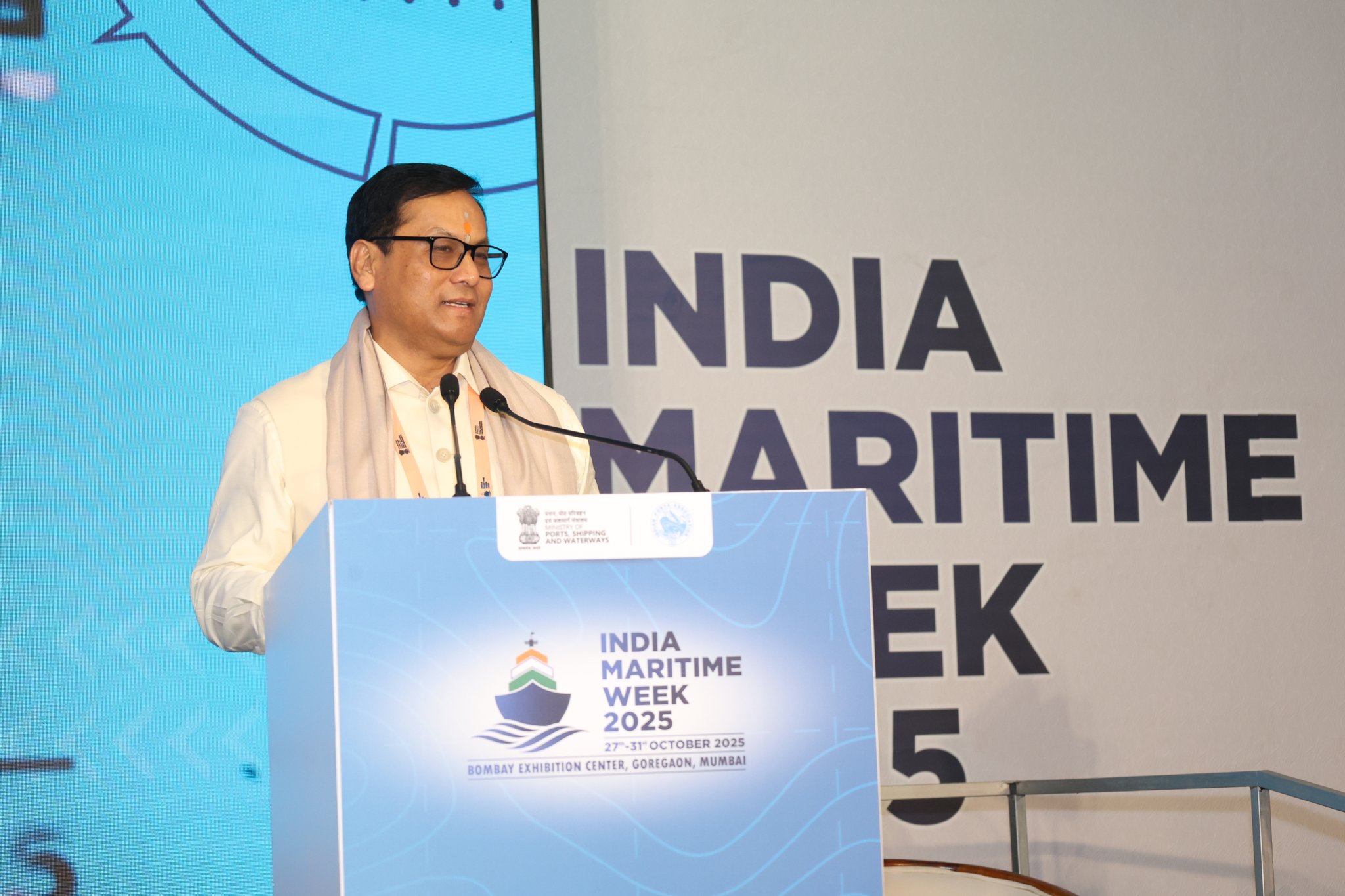India’s maritime sector remains central to its economic strength, with over 95 per cent of the nation’s trade by volume moving through the sea, Union Minister for Ports, Shipping and Waterways Sarbananda Sonowal said on Tuesday.
Speaking at India Maritime Week (IMW) 2025 on Green Maritime Day, Sonowal said, “It is a day that embodies our shared resolve to shape a cleaner and more sustainable future for global shipping.” He added that India’s Net Zero by 2070 commitment places the maritime sector at the heart of the country’s climate action efforts.
India Maritime Week 2025, organised by the Ministry of Ports, Shipping and Waterways from October 27 to 31 under the theme “Uniting Oceans, One Maritime Vision,” has brought together policymakers, industry leaders, and experts from across the world to deliberate on sustainable maritime development. The event has become a platform to reaffirm India’s focus on innovation, green growth, and maritime security.
Sonowal said India aims to cut carbon emissions per ton of cargo by 30% by 2030 and by 70% by 2047. He cited initiatives such as the Sagarmala Programme, Maritime India Vision 2030, Harit Sagar Guidelines, and the Maritime Amrit Kaal Vision 2047 as pillars of this transformation. “As we look toward Amrit Kaal 2047, our goal is not only to expand maritime capacity but also to make it greener, smarter, and more resilient,” he said.
The minister highlighted the National Green Hydrogen Mission as a game-changer, with VOC, Paradip and Deendayal Ports being developed as green hydrogen hubs. Together, they are expected to anchor a clean-fuel economy with over 12 million metric tonnes of green hydrogen-based e-fuel capacity already announced. “With our unique geography along key global trade routes, India is poised to become a hub for green shipping corridors, connecting domestic and international markets through clean energy trade,” Sonowal said.
The ministry also announced that India’s first national shore-power standard will enable vessels to draw clean electricity while docked, substantially reducing port-side emissions. Ports like Jawaharlal Nehru Port Authority (JNPA) have begun transitioning to battery-powered trucks and electric logistics systems as part of zero-emission operations.
“The maritime transition cannot be achieved in silos — it demands partnership among governments, industry, financiers, and technology leaders,” Sonowal said, urging global collaboration for a future where maritime trade drives both prosperity and sustainability.
Five major reports were released during the day, covering green hydrogen, e-fuels, zero-emission trucking, pollution control, and green port performance benchmarks.
Country sessions from Sweden and Norway highlighted India’s growing maritime diplomacy with Northern Europe. Sweden showcased advancements in AI-driven automation, LNG and green fuelling, and smart port systems, while discussions with Norway focused on technology partnerships and clean energy transition.
India’s Green and Digital Shipping Corridors (GDSCs) with Singapore and Rotterdam, launched earlier this year, were another highlight. “These partnerships will help scale investments and strengthen India’s position as a bridge between global trade and sustainable growth,” Sonowal said.
In a landmark step for defence shipbuilding, Mazagon Dock Shipbuilders Ltd. and Swan Defence & Heavy Industries Ltd. signed an agreement to construct Landing Platform Docks (LPDs) for the Indian Navy. The collaboration, the first major public-private partnership in defence shipbuilding, aims to combine public-sector legacy with private-sector capacity under the Atmanirbhar Bharat initiative.
The day also saw intense discussions on port modernisation, inland waterways, maritime safety, and the cruise economy. The session on “Ports as Engines of Transformation” focused on integrating digital technologies and developing climate-resilient infrastructure to boost port-led industrial corridors. Another session, “Reviving the Veins of Inland Trade,” saw experts stress the importance of inland waterways in reducing logistics costs and promoting green transport.
The “Guardians of the Sea” session addressed maritime safety and security, with representatives from the International Maritime Organization (IMO) and national agencies discussing cyber risks and autonomous vessel regulation. The HSSC Management Standard for harmonised safety practices was also released during the session.
Meanwhile, the “Cruise and Passenger Economy” session explored opportunities in cruise tourism, with Cordelia Cruises announcing plans to expand to 10 ships by 2031, adding Cochin and Vizag as new home ports. Another session, “Fortifying Global Supply Chains,” focused on enhancing digital integration across ports and logistics networks to strengthen trade resilience.
As discussions concluded, common themes of digitalisation, decarbonisation, skill development and regulatory simplification emerged as the driving forces behind India’s maritime transformation. The state sessions of Karnataka and Andhra Pradesh showcased regional potential across ports, fisheries, logistics and shipbuilding.
“India’s maritime renaissance is anchored in sustainability, innovation, and collaboration,” Sonowal said, summing up the spirit of the event. “The initiatives announced today reaffirm our commitment to ensuring that India’s maritime growth serves both the economy and the environment.”










